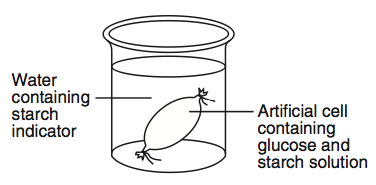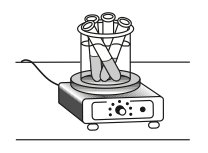Le Diffusion Lab Quiz

These questions deal with the diffusion lab we conducted. You get one chance for the quiz. If you are taking it during class, there is absolutely no talking during the quiz.
REMEMBER: PERIOD# followed by FIRST & LAST NAME
- 1.
Base your answers to this question on the laboratory setup illustrated below and on your knowledge of biology. Identify the color of the contents of the artificial cell after two hours. [1]
- 2.
Base your answers to this question on the laboratory setup illustrated below and on your knowledge of biology. After two hours, the color of the liquid in the beaker did not change. This shows that
- A.
Glucose moved from the artificial cell into the beaker
- B.
Starch did not pass out of the artificial cell
- C.
Starch was digested to glucose in the artificial cell
- D.
Glucose molecules combined to produce starch in the artificial cell
Correct Answer
B. Starch did not pass out of the artificial cellExplanation
The fact that the color of the liquid in the beaker did not change after two hours suggests that starch did not pass out of the artificial cell. If the starch had passed out of the artificial cell, it would have been broken down into glucose molecules, which would have caused a change in the color of the liquid. Therefore, the lack of color change indicates that the starch remained within the artificial cell and was not released into the beaker.Rate this question:
-
- 3.
Base your answers to this question on the laboratory setup illustrated below and on your knowledge of biology. This laboratory setup would most likely be used to demonstrate
- A.
Carbohydrate synthesis
- B.
Active transport
- C.
Diffusion
- D.
Dehydration
Correct Answer
C. DiffusionExplanation
This laboratory setup would most likely be used to demonstrate diffusion. Diffusion is the movement of molecules from an area of high concentration to an area of low concentration. In this setup, the molecules are shown moving from the beaker on the left to the beaker on the right, indicating the process of diffusion. Carbohydrate synthesis, active transport, and dehydration do not involve the movement of molecules from one area to another and are therefore not applicable to this setup.Rate this question:
-
- 4.
A laboratory technique is illustrated in the diagram below. The technique of lowering the coverslip at an angle is used to
- A.
Make organelles more visible
- B.
Reduce the formation of air bubbles
- C.
Make the specimen transparent
- D.
Reduce the size of the specimen
Correct Answer
B. Reduce the formation of air bubblesExplanation
Lowering the coverslip at an angle helps to reduce the formation of air bubbles because it allows the air to escape from underneath the coverslip as it is being lowered. This technique prevents the trapping of air bubbles between the coverslip and the specimen, which can interfere with the visibility of the organelles and make it difficult to observe the specimen accurately.Rate this question:
-
- 5.
Part of a laboratory procedure is shown in the diagram below. This setup would most likely be involved in a procedure to
- A.
Stain specimens while making a wet mount
- B.
Test for the presence of glucose using an indicator
- C.
Separate pigments in a mixture
- D.
Determine the pH of solutions
Correct Answer
B. Test for the presence of glucose using an indicatorExplanation
The setup in the diagram shows a test tube containing a solution and a test strip with an indicator. This indicates that the procedure is likely to involve testing for the presence of glucose using an indicator. The test strip with the indicator is commonly used to detect the presence of glucose in a solution by changing color in the presence of glucose. This setup is not suitable for staining specimens, separating pigments, or determining the pH of solutions.Rate this question:
-
- 6.
Base your answers to this question on the information below and on your knowledge of biology. A student prepared four different red blood cell suspensions, as shown in the chart below. Which suspension would contain red blood cells that would appear wrinkled and reduced in volume?
- A.
A
- B.
B
- C.
C
- D.
D
Correct Answer
B. BExplanation
Suspension B would contain red blood cells that appear wrinkled and reduced in volume. This is because the solution in suspension B is hypertonic, meaning it has a higher solute concentration than the red blood cells. In a hypertonic solution, water will move out of the cells through osmosis, causing them to shrink and wrinkle.Rate this question:
-
- 7.
Base your answers to this question on the information below and on your knowledge of biology. A student prepared four different red blood cell suspensions, as shown in the chart below. Which suspension would contain red blood cells that would appear wrinkled and reduced in volume?
- A.
Oxygen
- B.
Serum
- C.
Water
- D.
Salt
Correct Answer
C. WaterExplanation
The suspension containing red blood cells that would appear wrinkled and reduced in volume is water. This is because red blood cells are surrounded by a semi-permeable membrane that allows water to pass through. When red blood cells are placed in a hypotonic solution, such as water, water molecules will move into the cells through osmosis, causing the cells to swell and potentially burst. However, if the concentration of water outside the cells is higher than inside, the water will move out of the cells, causing them to shrink and appear wrinkled.Rate this question:
-
- 8.
Base your answers to this question on the information below and on your knowledge of biology. A student prepared four different red blood cell suspensions, as shown in the chart below. Which process is most likely involved in the change in red blood cell volume?
- A.
Active transport
- B.
Evaporation
- C.
Replication
- D.
Diffusion
Correct Answer
D. DiffusionExplanation
Diffusion is the most likely process involved in the change in red blood cell volume. Diffusion is the movement of molecules from an area of higher concentration to an area of lower concentration. In this case, the red blood cells in the suspensions may have different concentrations of solute, causing water molecules to move in and out of the cells to reach equilibrium. This movement of water molecules would lead to a change in the volume of the red blood cells.Rate this question:
-
- 9.
A substance is most likely to diffuse into a cell when (1) (2) (3) (4)
- A.
It is a large organic food molecule such as protein or starch
- B.
It is enclosed in an organelle such as a vacuole
- C.
The concentration of the substance is greater outside the cell than inside
- D.
The pH of the substance is greater than the pH of the cell
Correct Answer
C. The concentration of the substance is greater outside the cell than insideExplanation
Diffusion is the movement of molecules from an area of higher concentration to an area of lower concentration. Therefore, a substance is most likely to diffuse into a cell when the concentration of the substance is greater outside the cell than inside. This concentration gradient drives the movement of molecules into the cell until equilibrium is reached. The other options mentioned, such as the size of the molecule or the pH, do not directly affect the likelihood of diffusion into the cell.Rate this question:
-
- 10.
A laboratory setup using an artificial cell made from dialysis tubing is shown in the diagram below. Identify the process that would most likely be responsible for the movement of glucose from inside the artificial cell to the solution outside of the cell. [1]
Correct Answer
diffusionExplanation
Diffusion is the process that would most likely be responsible for the movement of glucose from inside the artificial cell to the solution outside of the cell. Diffusion is the passive movement of particles from an area of higher concentration to an area of lower concentration. In this case, since there is a higher concentration of glucose inside the artificial cell, it will naturally move down its concentration gradient and diffuse out of the cell into the solution outside.Rate this question:
Quiz Review Timeline +
Our quizzes are rigorously reviewed, monitored and continuously updated by our expert board to maintain accuracy, relevance, and timeliness.
-
Current Version
-
Mar 21, 2023Quiz Edited by
ProProfs Editorial Team -
Oct 19, 2012Quiz Created by
Ionca
 Back to top
Back to top



![Base your answers to this question on the laboratory setup illustrated below and on your knowledge of biology.
Identify the color of the contents of the artificial cell after two hours. [1]
Base your answers to this question on the laboratory setup illustrated below and on your knowledge of biology.
Identify the color of the contents of the artificial cell after two hours. [1]
- ProProfs](/quiz-school/user_upload/ckeditor/dif1.png)



![A laboratory setup using an artificial cell made from dialysis tubing is shown in the diagram below.
Identify the process that would most likely be responsible for the movement of glucose from inside the artificial cell to the solution outside of the cell. [1]
A laboratory setup using an artificial cell made from dialysis tubing is shown in the diagram below.
Identify the process that would most likely be responsible for the movement of glucose from inside the artificial cell to the solution outside of the cell. [1]
- ProProfs](/quiz-school/user_upload/ckeditor/diff5.png)